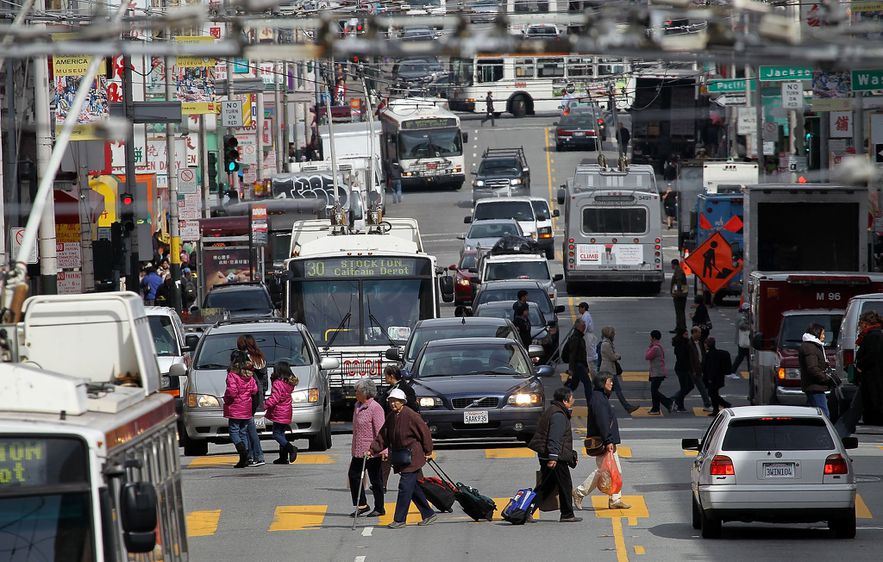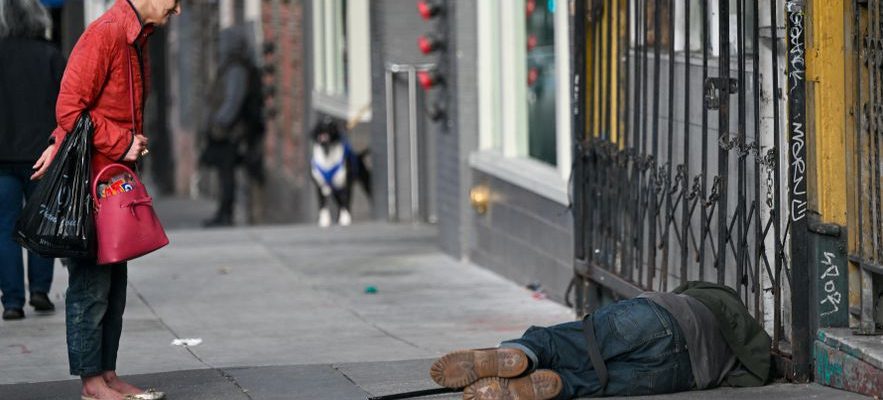On Market Street, directly opposite the tram terminus – the famous cable cars-, stands the Nordstrom department store, whose curving escalators are an attraction in themselves. As well known in San Francisco as Galeries Lafayette, the brand inaugurated in the 1980s – a golden age in California – has long been the commercial locomotive of the downtown. Alas, this institution closed its doors for good in August. Before her, dozens of other shops had already bowed out: H & M, Uniqlo, Office Depot, Gap, Marshalls, Abercrombie & Fitch… A carnage.
In an email to staff, the Nordstrom stores manager writes, “The dynamics of the downtown San Francisco market have changed dramatically over the past few years, impacting our store footfall and our ability to operate successfully.” Clearly: the problems of drugs on the public highway, shoplifting and, more generally, the climate of insecurity deter customers from frequenting what was the most popular store in the “city of 40 hills”. And it’s not just the customers! The employees themselves would prefer to work elsewhere.
In front of Nordstrom, wedged in his wheelchair, Daniel Harlan, a 72-year-old homeless man, takes stock of the situation: “For two, three years, it’s been worse than before, says this toothless Vietnam veteran. Every day , someone dies, stabbed to death, freezing to death or struck down by an overdose of fentanyl or other drugs,” he explains in his almost inaudible voice. He does not touch drugs but knows the street well: he has lived there since… 1989. However, he does not complain. The former Saigon-based GI, however, suffers from acute anxiety attacks, chronic depression and post-traumatic stress. But compared to other homeless people in the downtownhis situation seems almost enviable.
Because, a block from here, heading west, begins “Zombieland”, an urban Wild West where all the drug addicts from San Francisco have made an appointment. Most are stoned fentanyl, a synthetic product originally intended to relieve pain in cancer patients. Inexpensive and 50 times more lethal than heroin, it is at the heart of the opioid crisis which is ravaging the United States and of which the decadence of San Francisco gives the terrible measure.
“Fentanyl is driving people crazy!”
The city of San Francisco no longer looks like it did in the 80s. Its downtown has slowly turned into a no man’s land.
© / Anadolu Agency via AFP
In a perimeter of one square kilometer, in the heart of the Tenderloin district, which has become a lawless zone, the street scenes offer a dantesque spectacle. We come across thirty-year-olds bent over like old men, miserable people lying on the asphalt, drug addicts who, spoon and lighter in hand, prepare their shot in front of passers-by, trash-can diggers, hallucinated women pushing strollers without a passenger. On Ellis Street, in front of a makeshift tent surrounded by Caddies who form a line of defense, a prostitute in fishnet stockings and Doc Martens, staring blankly, offers five-dollar passes. Further on, in a doorway, a crouched zonard holds a dead cat (or so it seems) in his arms. Almost everywhere, the iron curtains are down, forever. In front of the shop window, only one sign remains: For Sale (for sale).
“In the buildings, the stairwells are full of used syringes,” says Isa Rodriguez, a young Mexican mother who will leave the neighborhood as soon as she can. “Once, she says, I was attacked at 11 a.m. in the middle of the street, for no reason. . He wasn’t even trying to rob me! Fentanyl is driving them crazy.” Another resident of the neighborhood, also Latino, testified: “When the police come to question them, they are not even afraid. As a result, the cops give up acting.” As a result, many San Franciscans vote with their feet: in the past three years, the city’s population has shrunk 18 percent, from 870,000 to 715,000. Some are moving elsewhere in California; d Others move to Texas and Florida, two states where taxation is attractive.
Downtown, there are knife and gun murders. But most people die from overdoses. In 2022, they killed nearly 600 people. This places San Francisco in the top 3 of the American cities most affected by drug-related deaths – just after Baltimore (on the east coast) and a locality in West Virginia (also east coast), a state ravaged by opioids. . Nationally, the number of overdose deaths has increased from 67,000 in 2018 to 107,700 by 2022! Two thirds of these OD are linked to powerful painkillers, of which fentanyl is the best known.
Venerable institution founded in 1865, the San Francisco Chronicle has created a statistical tool to measure overdoses at the national level (an additional 1 million in the United States since 1999). “In San Francisco, writes the daily, the incredible number of deaths affects all communities, but disproportionately affects the homeless and black people. The carnage is so important and so visible that London Breed, the mayor [démocrate]declared a temporary state of emergency at the end of 2021, then launched a campaign to crack down on drug trafficking.” Francisco will be higher than last year.
“People are dying like flies”

Stockton Street in San Francisco on March 26, 2012
© / afp.com/JUSTIN SULLIVAN
“People are dying like flies,” says Djamal, an American-Palestinian grocer on Ellis Street who, out of compassion, gives free cooked meals to some of his customers, who are not drug addicts but who are in financial difficulty. “The other day, he says, I found a guy lying stiff in front of my shop at six in the morning. At nine, he still wasn’t moving. So I called 911 [numéro d’urgence]. The guy was dead overnight. The cops asked me to help them carry the body because they didn’t want to do the job on their own,” said the shopkeeper, who was robbed three times in six months. Recently, the municipality awarded him a certificate of “Honor because he refuses to leave the neighborhood. But this medal hardly impressed this “resistant”: “The municipality makes promises but nothing changes”, he concludes, summing up the general feeling.
Elsewhere in San Francisco, residents are convinced that the city remains the most beautiful place in the world. And it’s true that with its Golden Gate Bridge, its Alcatraz Island, its Chinatown, its hills, its bay, its gay culture and its Victorian houses, not to mention its universities, the birthplace of Steve Jobs and Clint Eastwood remains unique. But the damage is done, and the reputation, damaged. “The San Francisco ‘product’ has become almost unsellable because it’s unpopular in the business world,” says Elen Gales, an event marketing pro who organizes trade shows. “In our com’, we rather use the names of Bay Area (the San Francisco Bay Area) or Silicon Valley,” she says, seated in a restaurant that looks like a Hooper painting. The numbers are there. In the conference market, the number of visitors has fallen to 400,000 per year from 900,000 before Covid. As a result, many hotels are going out of business, like the Hilton in the city center.
But all may not be lost. 200 meters from the former Nordstrom department store, Ikea has just opened another at the end of August, which gave rise to a ceremony with Mayor London Breed. “We know our city has a lot of challenges, she said before cutting the ribbon, but we also know that it’s the place where a lot of people want to live.” The main thing is to still believe in it, seemed to say the chosen one, helpless.
